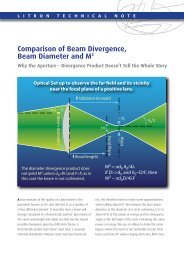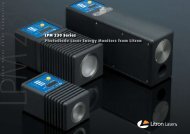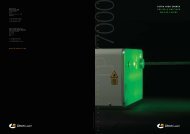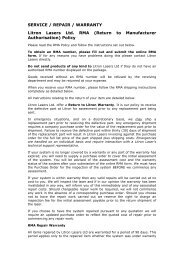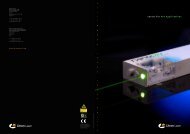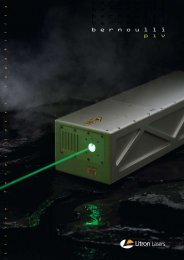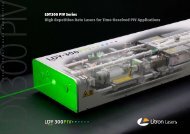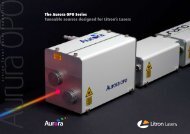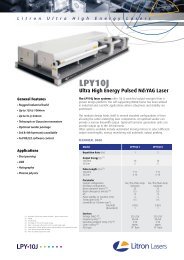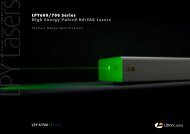Different Resonator Options from Litron - Litron Lasers
Different Resonator Options from Litron - Litron Lasers
Different Resonator Options from Litron - Litron Lasers
Create successful ePaper yourself
Turn your PDF publications into a flip-book with our unique Google optimized e-Paper software.
perture<br />
Rear Mirror<br />
Aperture<br />
Telescope<br />
L I T R O N T E C H N I C A L N O T E<br />
<strong>Different</strong> <strong>Resonator</strong> <strong>Options</strong> <strong>from</strong> <strong>Litron</strong><br />
<strong>Litron</strong> offers five distinct resonator configurations. This is more than any other manufacturer and<br />
this article sets out to help customers identify which one is best for their needs.<br />
Conventional Stable<br />
This multimode resonator has been around the<br />
longest time and is the simplest in terms of design.<br />
Typical characteristics are excellent energy extraction<br />
(measured as<br />
the amount of<br />
stored energy in<br />
the rod<br />
emerging in the pulse) and beam uniformity but<br />
somewhat high divergence and M2 Q-Switch<br />
Nd:YAG Rod<br />
Output Coupler<br />
values.<br />
Graded Reflectivity<br />
Conventional stable resonators Output Coupler allow the user to vary<br />
Aperture<br />
parameters such as input energy (flashlamp voltage)<br />
and repetition rate with very little variation in beam<br />
Q-Switch Nd:YAG Rod<br />
Output Coupler<br />
quality.<br />
Rear Mirror Q-Switch Nd:YAG Rod<br />
Output Coupler<br />
Rear Mirror Q-Switch Nd:YAG Rod<br />
Output Coupler<br />
Telescopic Stable<br />
Rear Mirror<br />
Q-Switch<br />
Nd:YAG Rod<br />
Output Coupler<br />
This variation on the multimode stable design places<br />
an intracavity telescope in the rear of the resonator.<br />
This has the two effects of compensating the thermal<br />
Graded Reflectivity<br />
Output Coupler<br />
Rear Mirror Aperture<br />
Telescope Q-Switch Nd:YAG Rod<br />
Output Coupler<br />
lensing in the laser rods and making the resonator<br />
appear considerably longer, without making it<br />
significantly more so, so reasonably short pulses are<br />
still obtained. The outcome is a laser beam with still<br />
very good spatial uniformity and efficient energy<br />
extraction but with much better divergence and M2 characteristics than a conventional stable resonator.<br />
The resonator is still flexible in terms of input energy<br />
and repetition rate and can be made even more so<br />
by means of adjustments to the telescope.<br />
Aperture<br />
Gaussian-Coupled Unstable<br />
This resonator comprises a P-branch confocal unstable<br />
resonator with a graded reflectivity mirror (GRM) for<br />
the output coupler. The rear mirror curvature is chosen<br />
so as to<br />
compensate<br />
the thermal<br />
lens in the<br />
rod and<br />
provide a more or less collimated output. The GRM<br />
unstable resonator provides lower values still for<br />
divergence and M2 Rear Mirror Nd:YAG Rod<br />
Rear Mirror<br />
Q-Switch<br />
Nd:YAG Rod<br />
Rear Mirror Aperture<br />
Telescope<br />
Nd:YAG Rod<br />
, with reasonable extraction<br />
efficiency but the downside is less uniform near field<br />
uniformity and much less flexibility in varying the<br />
input energy and repetition frequency.<br />
Q-Switch Output Coupler<br />
Output Coupler<br />
Graded Reflectivity<br />
Output Coupler<br />
Q-Switch Output Coupler
Rear Mirror Q-Switch Nd:YAG Rod<br />
Output Coupler<br />
Telescopic Rear Mirror Stable Q-Switch TEM00 Nd:YAG Rod<br />
Output Coupler<br />
This is a variation on the telescopic stable resonator<br />
that additionally employs an intracavity aperture to<br />
suppress higher order transverse modes to Graded allow Reflectivity the<br />
Output Coupler<br />
laser to give a beam with near diffraction limited,<br />
single mode TEM00 quality, with a uniform Gaussian<br />
Rear Mirror Aperture<br />
Telescope Q-Switch Nd:YAG Rod<br />
Output Coupler<br />
profile. Input energy and repetition rate flexibility are<br />
similar for the telescopic stable resonator but<br />
extraction efficiency is relatively low, being between<br />
a third and a quarter of the multimode telescopic<br />
stable resonator. As an option, <strong>Litron</strong> offers a suite of<br />
apertures to allow a user to obtain a range of beam<br />
quality and energy trade offs <strong>from</strong> TEM00 to<br />
multimode.<br />
<strong>Litron</strong> <strong>Lasers</strong> Ltd<br />
8 Consul Road,<br />
Rugby, Warwickshire<br />
CV21 1PB England<br />
Tel +44 (0)1788 574444<br />
Fax +44 (0)1788 574888<br />
Conventional Stable TEM00 Compared to a telescopic stable TEM00 laser, a<br />
smaller footprint, shorter pulse duration and greater<br />
input energy flexibility are the main benefits.<br />
However, lacking the telescope, the extraction<br />
Aperture<br />
efficiency is<br />
lower still.<br />
Rear Mirror Q-Switch Nd:YAG Rod<br />
Output Coupler<br />
Rear Mirror<br />
<strong>Litron</strong> <strong>Lasers</strong> North America<br />
2449 Arnica Drive,<br />
Bozeman,<br />
MT 59715 USA<br />
T +1 (406) 522 7566<br />
F +1 (406) 522 7567 www.litronlasers.com<br />
PB0114:1<br />
Q-Switch<br />
Nd:YAG Rod<br />
Output Coupler<br />
Graded Reflectivity<br />
Output Coupler<br />
Rear Mirror Aperture<br />
Telescope Q-Switch Nd:YAG Rod<br />
Output Coupler<br />
Beam Quality Focusability Extraction Flexibility in Input Energy<br />
(Uniformity) (M 2 ) Efficiency and Repetition Frequency<br />
Conventional Stable Excellent Poor (>10) Excellent (>90%) Excellent<br />
Telescopic Stable Very Good Very Good (3-4) Very Good (80%) Very Good<br />
GRM Unstable Poor Excellent (~2) Very Good (80%) Poor<br />
Telescopic Stable TEM 00 Excellent Most Excellent (~1.2) Poor (30%) Very Good<br />
Conventional Stable TEM 00 Excellent Most Excellent (~1.2) Very Poor (10%) Excellent<br />
For more information contact: <strong>Litron</strong> <strong>Lasers</strong><br />
Email: sales@litronlasers.com<br />
Comparison Table of <strong>Resonator</strong> Types




